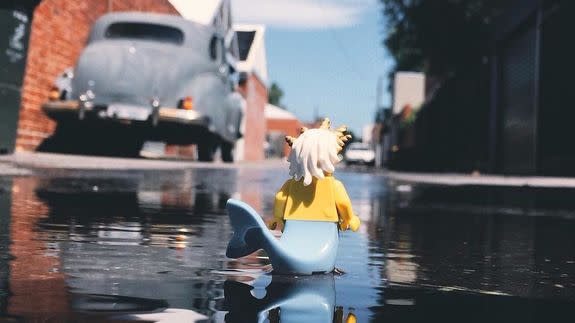'Legojacking' hijacks real life with Lego to create amazing art works

Letting our imaginations run wild with Lego seemed so easy as a child.
It's something most of us have forgotten about as adults. We're too busy looking over dreary Excel spreadsheets, trying our best to sort out our hectic lives — letting our once strong imaginations fall by the wayside.
SEE ALSO: Awful Australian election made more awful by awful Facebook Live videos
That's why Kanesan Nathan, 41, from Melbourne in Australia has received plenty of attention with an activity he calls "legojacking." It's the act of hijacking everyday environments with the aid of Lego, something which Nathan captures on his aptly named Instagram account, legojacker.
While the work often takes a serious tone, legojacking is fundamentally about inserting a sense of play in the usually dull and mundane environments in the world around us.
"A big part of what I've always done is the idea that it doesn't matter how old you are, you can still play," he told Mashable Australia. "Broadly, play is the idea of imagining and seeing the world through a completely different lens — which we used to do as kids, but we forgot while growing up."
It's an activity that helps people go back to the childhood way of seeing the world, while also regaining the creativity and imagination that gets lost in the daily humdrum of adult life.
After rediscovering Lego around six years ago, Nathan began his legojacking work but initially kept the photos to himself. His Instagram account started roughly a year later.
Nathan now has more than 100,000 followers, attributing the interest to strong focus of humanity in his work. "I'm not just taking a photo of toy — I'm taking a photo of a toy and saying this is what the world looks like to me," he said. "I think that's where it's really connected with people."
His legojacking images often reflect on and tell stories about world events, such as the treatment of asylum seekers, wars, riots and deaths. The 2013 riots in Turkey is something Nathan described as a "turning point" in his work.
"I knew some Instagrammers in Turkey and I saw their accounts of the riots. I decided to use their words and do a photo of a Lego riot," he said.
"The most amazing thing for me is that people in Turkey were saying 'thank you so much for sharing our story.' It really means a lot that people on the other side of the world care. It was something that meant a lot to them."
Nathan admits he rarely plans out his legojacking work, mostly creating his photos on an impulse.
"It starts off on a whim, and then you spend hours [on it]," he laughed. "The whole idea of play is that you don't have a sense of what you're going to do, you're just open to doing it."
Sometimes it's clear to Nathan what a legojacking photograph should look like. This is best exemplified in a recent work which pays respect to the victims of the Orlando mass shooting, which features Lego characters in the colours of the LGBTQ flag.
"I had a very clear idea of how I wanted to represent it, but that's quite rare. Normally I take a bag of characters out with me and respond to the environment. Then when I come home I think, 'how am I going to position this?" he said.
Nathan's photographs are shot on an iPhone, preferring to use generic characters from the Lego Minifigures set in his work, as they tend to be more versatile.
Occasionally he'll use special edition Lego characters that reference pop culture, such as Disney Lego and The Simpsons Lego, if there are any comedic or ironic possibilities.
For example, Nathan used The Simpsons characters in a commentary about the global refugee crisis and the alien character from Toy Story to protest against random visa checks in Melbourne.
Nathan has recently resigned from his day job to take advantage of the opportunities that have arisen from legojacking, such as working with places or organisations to create unique content. He said his photography can help brands become more accessible.
In the future, he'd also like to use legojacking to promote kindness and empathy on a global scale.
"Play is a really great way of promoting understanding, and that's what I've always tried to do in my work," he said. "I think through a simple act you can change the world, or change someone's opinion. That's the next step."
